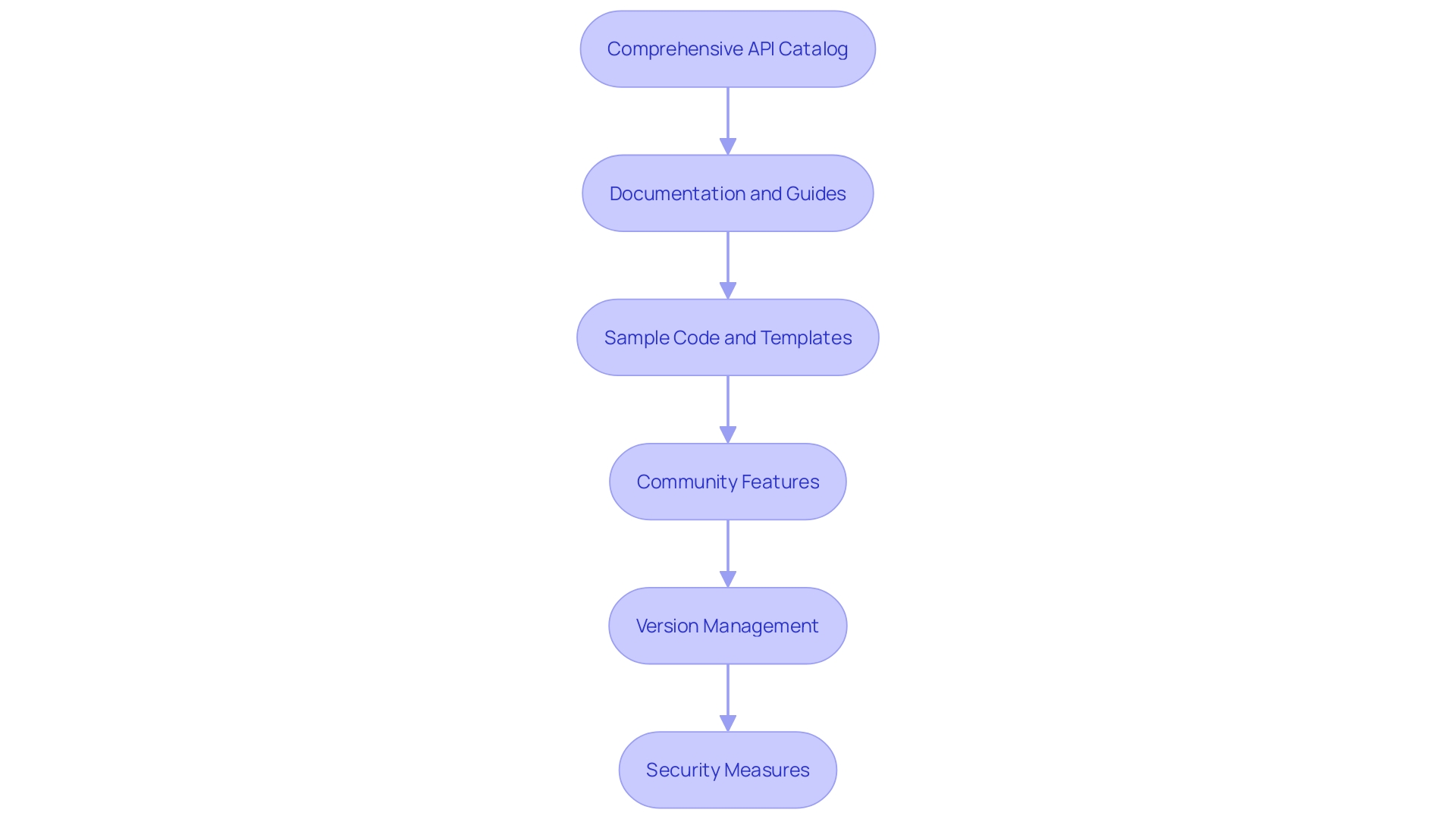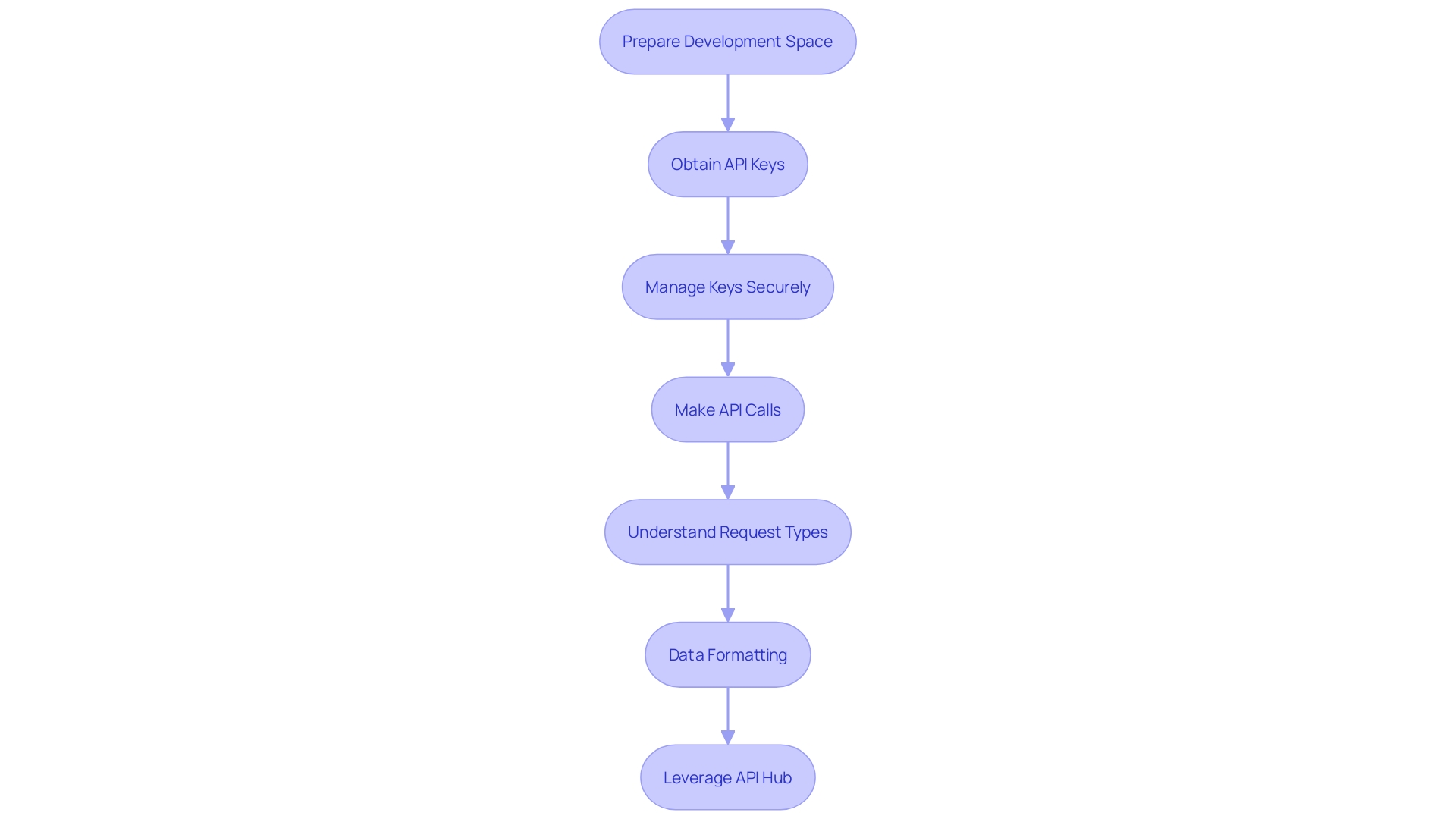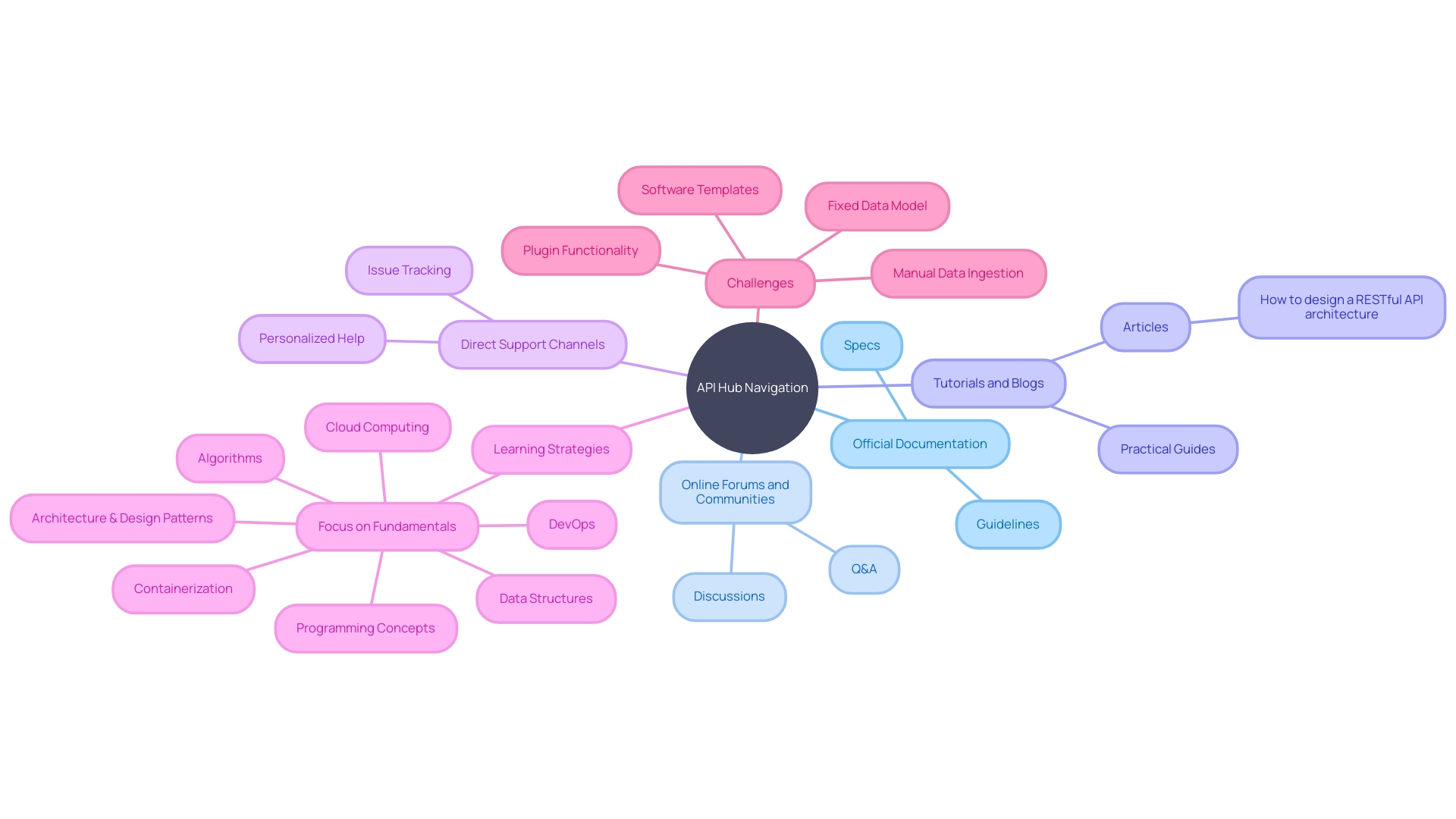Introduction
API Hubs have become indispensable for modern software development, offering a centralized platform for accessing and managing Application Programming Interfaces (APIs). With the ability to streamline integration processes and enhance productivity, API Hubs provide numerous benefits for developers and organizations alike. From centralized access to APIs and consistent documentation to development accelerators and community engagement, these platforms offer a range of features that boost efficiency and collaboration.
Moreover, API Hubs play a crucial role in addressing operational bottlenecks and ensuring security. As the industry recognizes the strategic value of APIs, the adoption of API Hubs becomes essential for driving digital transformation forward. In this article, we will explore the benefits, key features, best practices, troubleshooting common issues, and additional resources related to using an API Hub.
Whether you are a developer looking to optimize your workflow or an organization aiming to maximize the potential of APIs, this article will provide valuable insights and guidance for leveraging API Hubs effectively.
Benefits of Using an API Hub
API Hubs streamline the integration and management of Application Programming Interfaces (APIs), the essential building blocks of modern software development. These platforms offer a centralized location for accessing APIs, enhancing the efficiency and productivity of developers and organizations alike. Here are several advantages of utilizing an API Hub:
- Centralized Access to APIs: Developers can easily locate and utilize a diverse array of APIs through a centralized catalog provided by an API Hub.
- Consistent and Detailed Documentation: Standardized documentation that details endpoints, parameters, and expected response formats is essential for seamless API integration.
- Development Accelerators: Sample code and templates available on API Hubs can significantly speed up the development process by offering reliable starting points.
- Community Engagement: API Hubs encourage collaboration by providing community features like forums and chat rooms, where developers can assist each other and share knowledge.
- Versioning and Security: With robust version management, developers can handle various API versions effectively, avoiding compatibility issues. Additionally, API Hubs implement security protocols to safeguard sensitive data and prevent unauthorized access.
In the context of efficiency, the importance of API Hubs is underscored by their role in resolving operational bottlenecks. For instance, Delivery Hero tackled the challenge of account recovery delays by leveraging API technology to streamline processes, resulting in significant time savings. Similarly, Goosehead Insurance's commitment to operational control and security in their technology stack, including Heroku Shield, exemplifies the need for robust API management to maintain industry compliance and secure data.
Moreover, with API-related security incidents on the rise, as reported by 78% of cybersecurity teams, the role of API Hubs in providing inventory, visibility, and prioritization of API security has become more critical than ever. As the industry recognizes the significance of APIs as not just a technological asset but also a strategic one, the adoption of API Hubs becomes a key factor in pushing digital transformation forward.
With the increasing complexity of the digital landscape, the need for platforms that address multiple customer needs is evident. As one expert put it, focusing on the real 'needs' versus 'wants' can lead to building the right solutions with lasting impact. API Hubs are at the forefront of this shift, offering the tools and environment for developers to create innovative solutions that meet the evolving needs of the market.
Key Features of an API Hub
API Hubs streamline the developer experience with an abundance of features that enhance productivity. At the heart of an API Hub lies its Comprehensive API Catalog, serving as a one-stop repository where APIs are neatly categorized, ensuring that developers effortlessly locate the APIs suited for their tasks. The inclusion of Documentation and Guides is pivotal; it equips developers with in-depth instructions and insights, smoothing the path of API integration.
Furthermore, API Hubs provide Sample Code and Templates. These ready-to-use resources are invaluable, sparing developers from starting from scratch and allowing for easy customization to fit specific needs. In the realm of collaboration, API Hubs offer Community Features, like forums and chat rooms, which are crucibles for collective problem-solving and sharing best practices.
Lastly, the Version Management and Security measures within API Hubs are critical. They not only facilitate the handling of multiple API iterations to ensure seamless integrations but also shore up security with robust authentication and encryption standards.

Getting Started with an API Hub
Embarking on the journey of utilizing an API Hub involves a structured process that begins with preparing your development space. The initial phase is to equip your environment with the necessary software and configuration to support API integration. Next, you'll need to obtain API keys from the API Hub, which serve as essential credentials to authenticate and interact with the APIs.
Managing these keys securely is crucial to protect your access and maintain system integrity.
Once your environment is ready and API keys are securely managed, you can proceed to make API calls. Understanding the correct usage of various request types, such as GET, POST, PUT, and DELETE, is fundamental to successful API interactions. This knowledge will enable you to send and receive data effectively, facilitating seamless communication with the API.
The data exchanged with APIs is typically formatted in JSON or XML. Mastery in data formatting ensures that you can parse and construct data payloads that align with the API's expectations, thereby avoiding potential communication breakdowns.
Leveraging the power of an API Hub not only streamlines the process of integrating APIs into your projects but also underpins the "API-first" development approach. This strategy prioritizes the creation of APIs that are accessible, developer-friendly, and compatible with a variety of applications and systems, fostering a more flexible and adaptable technological ecosystem.
As APIs continue to serve as the bedrock of modern software development, their strategic implementation can lead to innovative collaborations and enhanced system functionalities. With APIs recognized as the 'crown jewel' of software development, their thoughtful integration through an API Hub positions your projects at the forefront of digital transformation.

Best Practices for API Development and Integration
In the realm of API development and integration, adopting certain best practices can significantly enhance the effectiveness and reliability of your applications. Start with Clear and Consistent Naming Conventions: a straightforward approach to naming your endpoints, parameters, and response fields can greatly reduce confusion and increase the ease of use for developers engaging with your API.
For Thorough Documentation, aim to supply a complete set of documentation that is clear, instructive, and includes practical code examples and essential concept explanations. This level of detail is key in helping developers to grasp and efficiently utilize your API. Error Handling and Status Codes are next; by utilizing proper error management and relevant HTTP status codes, developers can more quickly identify and resolve issues they encounter.
When it comes to Version Control, it's vital to manage your API versions to maintain compatibility and facilitate smooth transitions with updates. Lastly, Testing and Monitoring should be ongoing to assure the API's functionality and performance, using monitoring tools to keep track of usage, spot any performance bottlenecks, and to continuously refine performance.
Embracing these best practices is not just about creating a technically sound API—it's about fostering an environment where developers can thrive. As Mike Sedzielewski, co-founder of Voucherify, points out, leveraging external APIs can exponentially increase productivity, turning an ordinary team into a powerhouse that developers worldwide come to rely on. This is echoed by Aluisio, a seasoned software engineer, who emphasizes the importance of tailored integration strategies based on your unique context, starting with requesting comprehensive documentation.
The importance of APIs in today's software landscape cannot be overstated. They serve as the translators between disparate software, allowing for complex and powerful integrations. As noted by Google, APIs are the crown jewels of software development, enabling innovation and collaboration across various industries.
By following these best practices, you ensure that your API can serve as a robust, efficient, and indispensable tool in the modern developer's toolkit.
Troubleshooting Common Issues
When integrating third-party services via APIs, it's not uncommon to face hiccups. The key to a seamless integration lies in effective troubleshooting. Start by thoroughly reviewing the API documentation, which is your roadmap to using the service correctly.
It should clearly define the available endpoints, required parameters, and outline authentication protocols. In fact, well-structured API documentation is the first step to successful onboarding, as it helps users quickly understand how to interact with the service.
Next, ensure your API key is accurate and properly set up. An incorrect or misconfigured API key is often the culprit behind failed requests. If you're facing persistent issues, consider testing your network connectivity to confirm that your requests are reaching the API server.
A stable internet connection is a fundamental requirement for API communication.
Pay close attention to the response codes you receive. These codes are indicative of the nature of the issue you're encountering. For instance, a '429 Too Many Requests' response code signals that you've hit the rate limit, an issue not uncommon in today's API-centric world.
Rate limits are designed to control traffic and maintain service stability, and exceeding these limits can bring your operations to a halt, as experienced by a critical microservice in a real-world production incident.
To dive deeper into the problem, make use of debugging tools and logging libraries. These resources are invaluable for monitoring the API requests and responses, allowing you to track down and analyze the source of the problem. This approach to incident management—systematic and proactive—can help prevent API downtime and ensure that your integration efforts are not just effective, but also resilient against common pitfalls.
Additional Resources and Community Support
Navigating an API Hub can be greatly enriched by tapping into the collective knowledge and resources available. Official documentation serves as a cornerstone, offering comprehensive information and user guides meticulously crafted by professionals like the GitHub Docs team, who ensure developers have access to top-notch materials.
Engaging with online forums and communities, such as those nurtured by companies like Microsoft and SmartBear, provides a platform for dialogue, knowledge exchange, and peer support. These communities are vital in fostering a supportive ecosystem where developers can seek advice and share their own expertise.
In-depth tutorials and blogs offer a wealth of practical advice and use cases. They echo the wisdom of industry experts who stress the importance of focusing on user needs rather than wants, just as financial institutions have learned through extensive experience.
Lastly, direct support channels like email or live chat provide personalized assistance, ensuring that specific issues or inquiries are addressed promptly. This level of support echoes the sentiment of the Vanson Bourne research, which underscores the critical role of APIs in enhancing organizational connectivity and avoiding siloed operations.
By leveraging these resources, developers can not only improve their proficiency with an API Hub but also contribute to the innovation and efficiency that APIs bring to the software development landscape.

Conclusion
API Hubs are crucial for modern software development, streamlining integration processes and enhancing productivity. They provide centralized access to APIs, consistent documentation, development accelerators, and community engagement features. API Hubs address operational bottlenecks and ensure security through robust version management and security protocols.
The adoption of API Hubs is essential for driving digital transformation forward, maximizing the potential of APIs, and addressing the rising number of API-related security incidents.
Key features of API Hubs include a comprehensive API catalog, detailed documentation, sample code and templates, community features, and robust version management and security measures. These features improve productivity and the developer experience.
Getting started with an API Hub involves preparing the development space, obtaining API keys, and learning how to make API calls. Leveraging an API Hub supports an "API-first" development approach, creating flexible and adaptable technological ecosystems.
Best practices for API development and integration, such as clear naming conventions, thorough documentation, proper error handling, version control, and testing and monitoring, enhance the effectiveness and reliability of applications. These practices foster a productive environment for developers.
When troubleshooting common issues in API integration, thorough review of API documentation, accurate API key setup, testing network connectivity, and monitoring response codes are crucial. Debugging tools and logging libraries help identify and analyze problems, ensuring effective integration.
Additional resources and community support, such as official documentation, online forums, communities, tutorials, blogs, and direct support channels, provide comprehensive information and assistance.
In summary, API Hubs are indispensable for modern software development, providing centralized access to APIs, streamlining integration, and enhancing productivity. They address operational bottlenecks and ensure security, playing a vital role in driving digital transformation. By leveraging key features, best practices, and troubleshooting techniques, developers can maximize the potential of APIs and contribute to the efficiency of the software development landscape.
Frequently Asked Questions
What is an API Hub?
An API Hub is a platform that provides a centralized location for accessing and managing various Application Programming Interfaces (APIs), simplifying the process of integration and enhancing developer productivity.
What are the main benefits of using an API Hub?
Benefits include centralized access to a diverse array of APIs, consistent and detailed documentation, development accelerators like sample code and templates, community engagement features, and robust versioning and security protocols.
How can API Hubs impact operational efficiency?
API Hubs can resolve operational bottlenecks, as demonstrated by companies like Delivery Hero and Goosehead Insurance, leading to time savings, increased control, compliance, and secure data management.
Why are API Hubs becoming critical for cybersecurity?
With a rise in API-related security incidents, API Hubs provide essential inventory, visibility, and prioritization for API security, helping prevent unauthorized access and data breaches.
What are the key features of an API Hub?
Key features include a comprehensive API catalog, in-depth documentation and guides, sample code and templates, community features for collaboration, and measures for version management and security.
How do you get started with using an API Hub?
Begin by preparing your development space with the necessary software, obtain and manage API keys securely, and understand how to make API calls with different request types and data formats.
What is the 'API-first' development approach?
The 'API-first' development approach prioritizes creating accessible, developer-friendly APIs that are compatible with various applications and systems, supporting a more adaptable technological ecosystem.
What best practices should be followed in API development and integration?
Best practices include clear and consistent naming conventions, thorough documentation, proper error handling and status codes, careful version control, and ongoing testing and monitoring.
How do you troubleshoot common issues when integrating APIs?
Troubleshooting steps include reviewing API documentation, checking API keys, testing network connectivity, understanding response codes, and utilizing debugging tools and logging libraries.
Where can you find additional resources and community support for API Hubs?
Additional resources and support are available through official documentation, online forums and communities, in-depth tutorials and blogs, and direct support channels like email or live chat.




